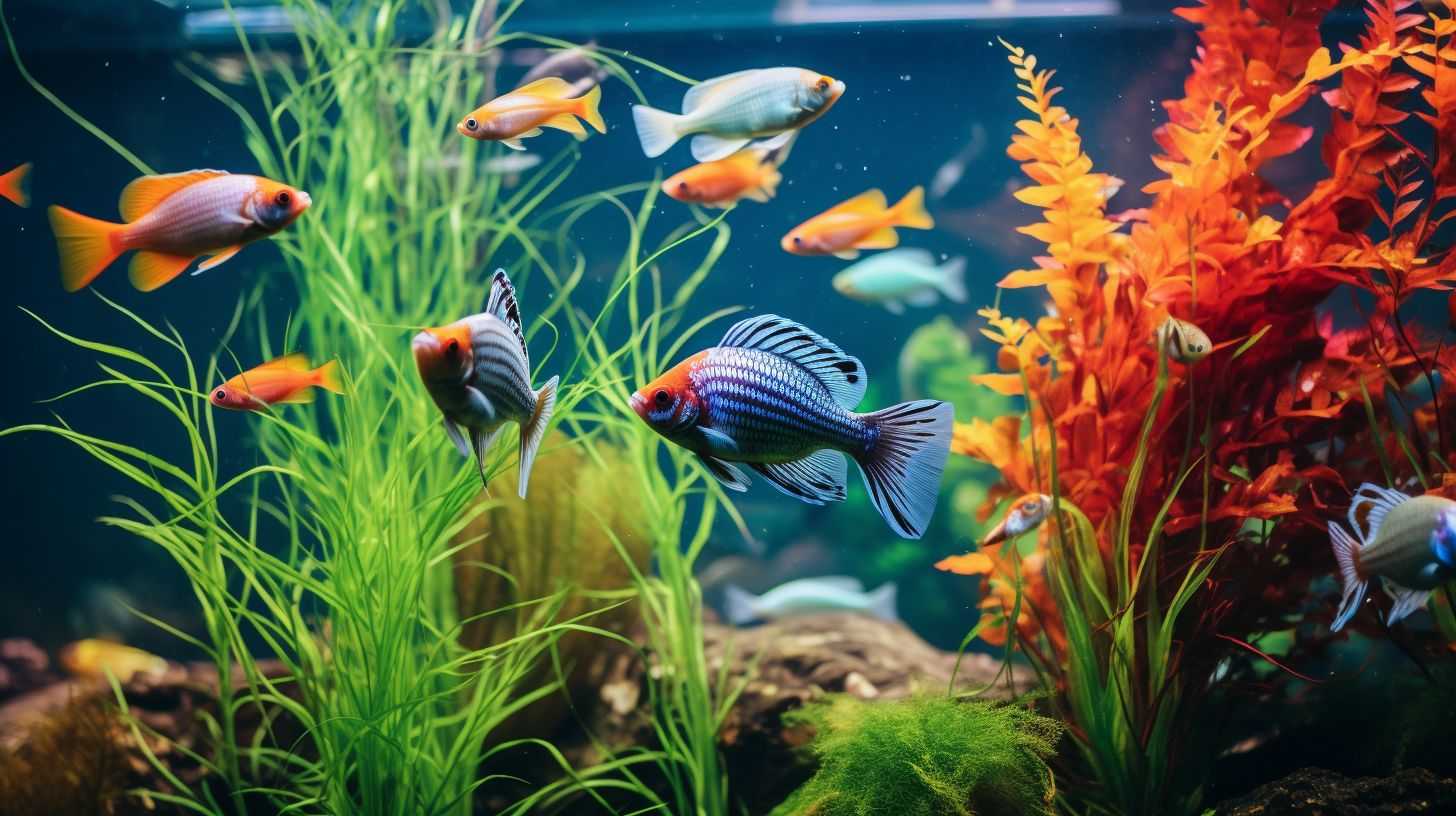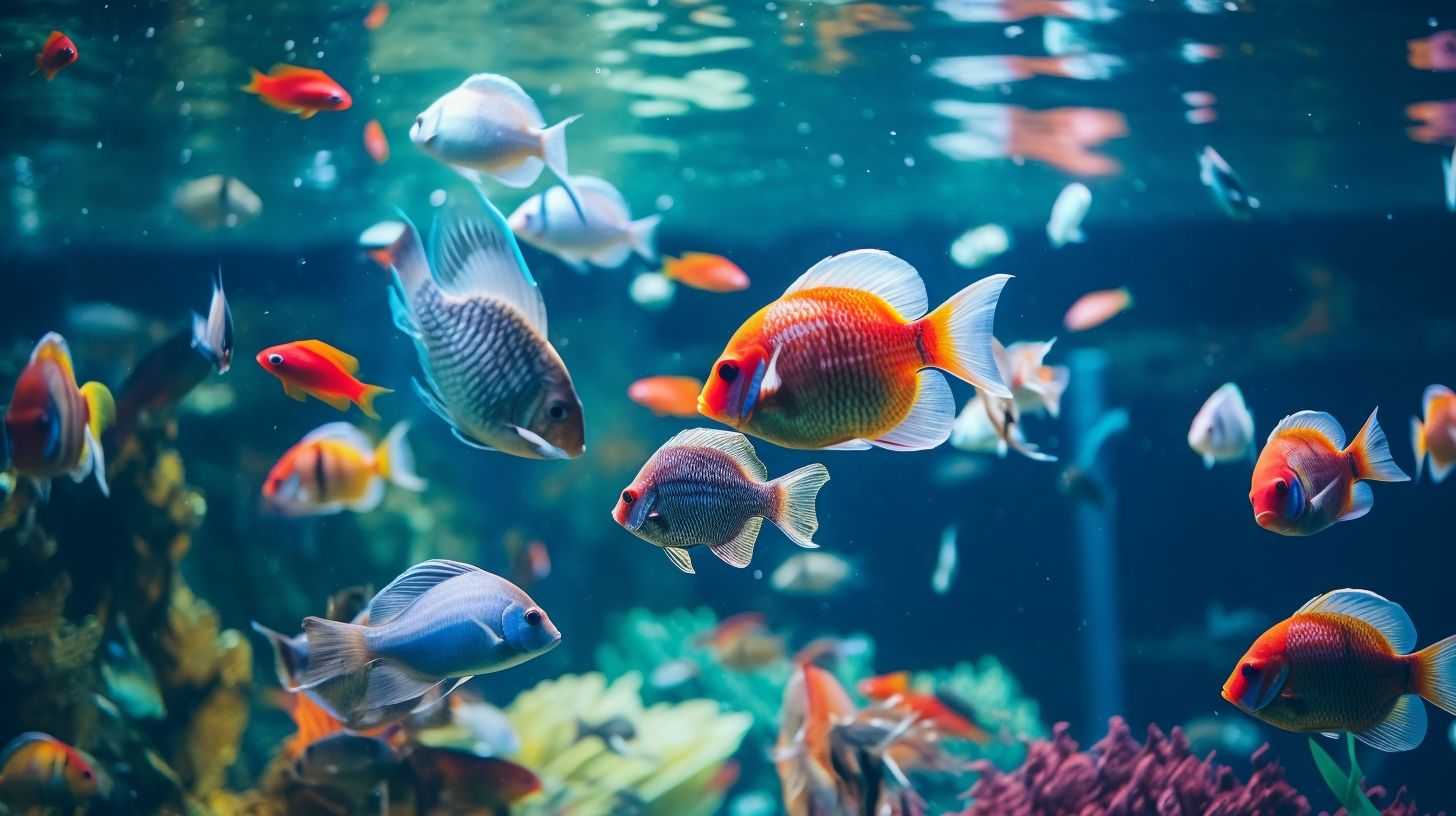Ever find yourself scratching your head in puzzlement when your aquarium isn’t quite as spotless and crystal-clear as you envisioned, despite hours dedicated to cleaning? Believe me, I understand the struggle.
When elbow-deep scrubbing doesn’t cut it anymore, it’s time take a page out of the pros’ book. After immersing myself in research, talking to fish care experts and poring over aquatic veterinary studies – including gathering golden nuggets of wisdom from seasoned aquarists – I’ve come to realize that pristine tanks are the product of a consistent and efficient cleaning routine.
Ready for some insider secrets on how to metamorphose that clouded tank into a sparkling habitat for your underwater friends? Let’s jump right in!
Key Takeaways

- Regular cleaning of your fish tank is important for the health and happiness of your fish. Dust, waste, algae, and leftover food can build up and lead to bad smells, poor visibility, and even disease.
- Gather all necessary cleaning supplies like a safe scrub for glass or acrylic tanks, a gravel vacuum to clean between rocks at the bottom of the tank, hot water and a toothbrush for cleaning decorations, and towels for drying.
- Remove fish and decorations from the tank before cleaning. Carefully place the fish in a separate bowl with water from the tank to keep them stress-free. Clean all decorations thoroughly using hot water and a toothbrush.
- Clean the inside of the tank by unplugging filters and lights for safety. Use an appropriate scrub to remove grime from the walls. Use a gravel vacuum to clean substrate crevices.
- Replace some of the water in your tank but avoid changing more than 50% at once to prevent temperature or pH fluctuations that can harm your fish. Test tap water pH levels before adding it back into the tank. Treat tap water with dechlorinator due to harmful chlorine or chloramine content.
- Gently reintroduce your fish into their cleaned tank by acclimating them slowly over 15 – 20 minutes before releasing them fully.
Importance of Cleaning a Fish Tank

A clean fish tank means happy and healthy fish. Dust, waste, algae and left-over food can build up in a dirty tank. This mess may lead to bad smells, poor views of your aquatic friends, or even disease.
Fish are very sensitive to changes in their home. If the water is not right, they get sick easily. Cleaning doesn’t just mean clear water for us to see through; it’s about making sure our fins friends have a safe place to live.
Make cleaning a regular task! Get rid of dirt but also be careful about sudden changes in the tank’s environment. It’s important not to change more than 50% of the water at once because big shifts in heat and pH levels could harm the fish.
Step-by-Step Guide to Cleaning a Fish Tank
First, gather all the necessary cleaning supplies such as a bucket, algae scraper, filter brush, and water treatment solution.
Gather necessary cleaning supplies
To clean a fish tank, you need the right tools. First, buy a scrub that is safe for glass or acrylic. This kind of scrub won’t scratch your tank. Also, get a gravel vacuum. It helps to clean spaces in between the rocks at the bottom of your tank.
Next, prepare hot water and a toothbrush to wash any fake plants or toys from your fish tank. Don’t forget to have towels ready too. You will use them to dry off when done with cleaning everything wet.
Lastly, make sure you have all this before starting so you do not miss anything out.
Remove fish and decorations
First, let’s carefully take the fish out of their tank. We put them in a safe bowl filled with some water from the tank. This keeps our fish happy and stress-free while we clean their home.
Next, we need to take out all the decorations like rocks, plants, and toys from the tank. These items may have bits of food or waste on them that we need to clean off. Doing this makes it easier for us to reach every part of the tank and helps us do a good cleaning job!
Clean the inside of the tank

Start by washing your hands and arms. This will keep dirt off the tank. You can then unplug filter and lights for safety. Take out all the toys from the tank too! Grab a scrub that won’t scratch your tank – acrylic-safe for plastic tanks, glass scrub for glass ones.
Use it to rub away the grime on your tank walls. Put water into a gravel vacuum to clean out tiny bits hiding in substrate crevices, this will catch any fish waste or extra food too.
Clean the decorations
To keep your aquarium clean and ensure the health of your fish, it’s important to clean the decorations regularly. This helps remove any algae or debris that may have built up over time.
To do this, simply scrub the synthetic decorations with hot water and a toothbrush. Be sure to avoid using detergent, as it can be harmful to your fish. Use an appropriate acrylic-safe or glass scrub depending on the material of your tank.
Remember, glass scrubs are more abrasive and can scratch acrylic tanks, so choose accordingly. Cleaning the decorations is a crucial step in maintaining a healthy and vibrant aquarium for your angler friends!
Replace the water
To replace the water in your fish tank, start by refilling a bucket with tap water. But before pouring it into the tank, make sure to test its pH and KH levels using a testing kit.
This will help ensure that the water is suitable for your fish. Next, add a dechlorinator to treat any chlorine or chloramine in the tap water, as these can be harmful to fish. Slowly pour the treated water back into the tank to avoid creating a heavy current that may harm your fish.
Remember not to remove more than 50% of the tank water at once, as this could cause temperature and pH fluctuations which can stress out your fish.
Reintroduce the fish
After cleaning the fish tank and replacing the water, it’s time to reintroduce your fish. Gently place them back into the tank using a net or cup to avoid causing stress or injury.
It’s important to acclimate them to their new environment by slowly adding small amounts of tank water into the container they are in over a period of 15-20 minutes. This will help them adjust to any differences in temperature or water chemistry between their temporary container and the main tank.
Once they have been properly acclimated, release them gently into the tank. Keep an eye on their behavior for any signs of stress or illness in case you need to take further action.
Common Issues After Cleaning

Excessive noise, fish breathing heavily, and persistent algae can be common issues that arise after cleaning your fish tank. Discover how to address these problems and keep your aquarium in optimal condition.
Excessive noise
Excessive noise in your fish tank can be really annoying, but there are ways to fix it. One common cause of noise is air trapped in the filtration system. To solve this, you can try re-priming the system by unplugging and then plugging it back in.
If that doesn’t work, contacting the manufacturer for assistance is a good idea. They can provide guidance on how to resolve the issue or offer solutions specific to your filter model.
Remember to always unplug the filter and lights before cleaning your tank to avoid damaging the mechanical parts when they’re dry. By troubleshooting and addressing these common issues, you’ll be able to enjoy a peaceful and quiet fish tank experience.
Fish breathing heavily
If you notice your fish breathing heavily, it could be a sign of poor water quality in the tank. Sudden changes in temperature and pH levels can also cause fish to breathe heavily.
This may indicate a lack of oxygen in the water. One possible reason for this is poor filtration or too much waste in the tank. After cleaning the tank, if you see your fish breathing heavily, it might be because the cleaning process has disrupted the balance of good bacteria in the tank.
So it’s important to make sure you maintain good water quality and provide enough oxygen for your fish to stay healthy.
Persistent algae
After cleaning your fish tank, you may notice the presence of persistent algae. Don’t worry, this is a common issue that can be easily addressed. To remove persistent algae from synthetic décor, use hot water and a toothbrush to scrub it gently.
If you have a glass tank, an abrasive glass scrub can effectively remove the algae. When cleaning the substrate with a gravel vacuum, make sure to focus on removing any debris or waste that may contribute to the growth of algae.
Additionally, rinsing or squeezing the filter media in collected waste water can help eliminate persistent algae. By following these steps, you can keep your fish tank clean and free from unwanted algae growth.
Conclusion

In conclusion, cleaning your fish tank is essential for keeping your aquarium healthy and your fish happy. By following the step-by-step guide provided in this article, you can ensure that you maintain a clean and safe environment for your underwater friends.
With regular maintenance and proper care, you can enjoy a beautiful and thriving fish tank for years to come. So roll up those sleeves, grab the necessary supplies, and get ready to give your fishy companions the clean home they deserve!
FAQs
1. How do I start cleaning my fish tank properly?
You start by washing your hands and arms, removing synthetic decor, and gently cleaning the glass of the fish tank.
2. Can I clean a fish tank without removing the fish?
Yes, you can clean a fish tank with live plants or sand in it without removing the water or killing any of the fishes in it.
3. What should I do after removing items from my fish tank?
After taking out things from your aquarium, rinse them carefully. Then re-fill your bucket with tap water and add dechlorinator before placing back all your décor in their right places.
4. How to maintain a healthy temperature inside my aquarium when cleaning?
Your aquarium’s water temperature is crucial for maintaining its balance! Use an infrared thermometer to monitor this while cleaning so that changes won’t harm your pets’ health.
5. What steps should be taken after putting everything back into the aquarium?
Once everything is back into place, prime your filtration system then switch on UV lights or regular lights if you have them installed for efficient routine cleaning.
6.Do commercial products help to keep my freshwater and saltwater tanks clean?
Commercial products like buffers and mineral additives can be used depending on what kind of water source suits specific needs of your particular types of fishes.
